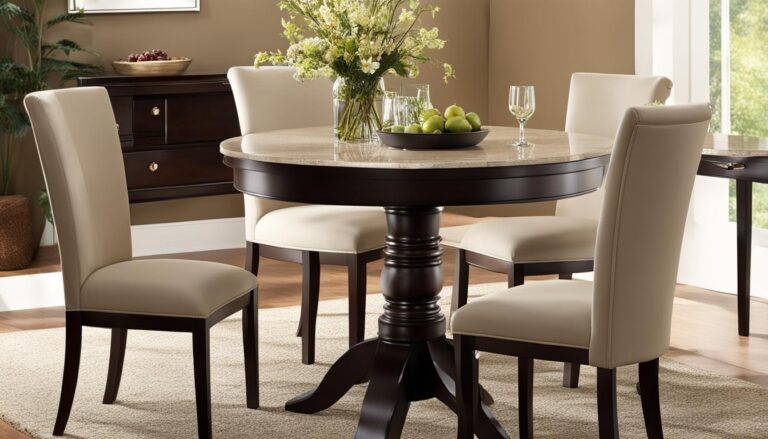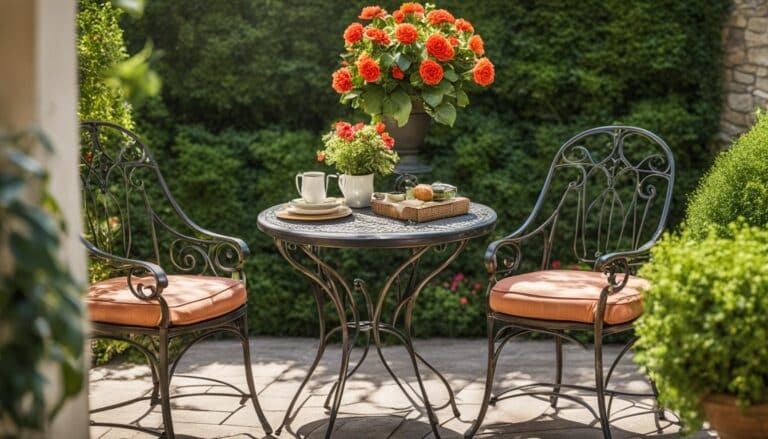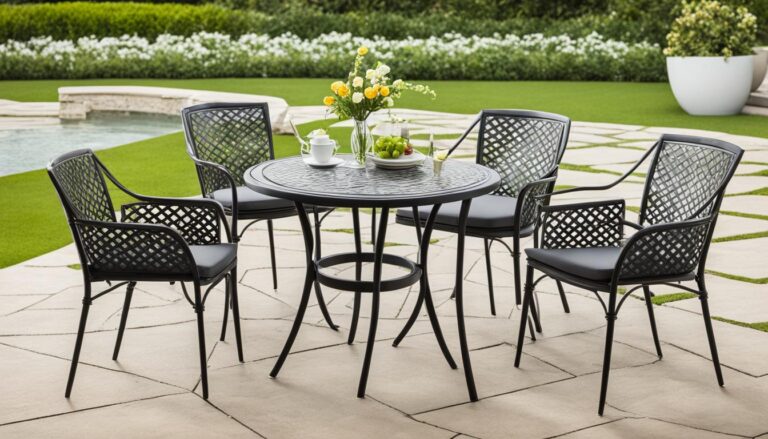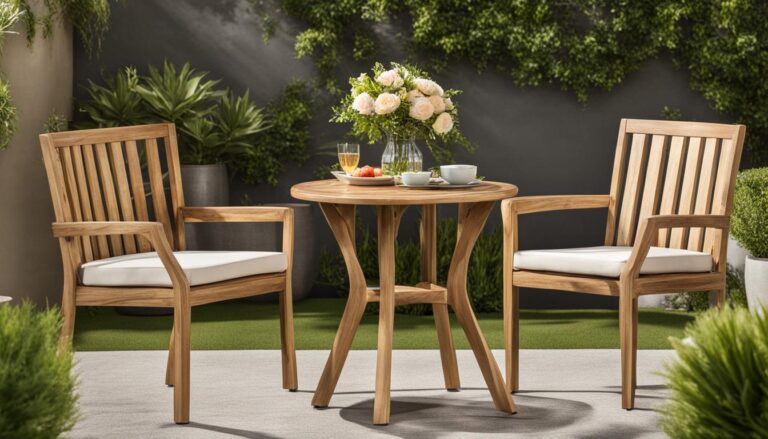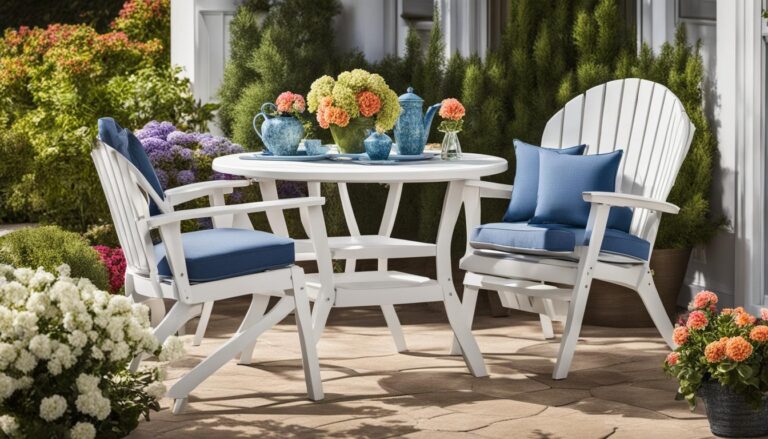Mold and mildew can easily accumulate on outdoor furniture due to exposure to moisture from precipitation and humidity. If left untreated, it can not only damage your furniture but also pose a health risk to you and your family. In this guide, we will provide you with practical tips on how to effectively remove mold from your outdoor furniture, ensuring it stays clean and mold-free.
Key Takeaways:
- Wear gloves and a mask while cleaning to protect yourself from mold spores.
- Follow the manufacturer’s instructions on cleaning products.
- Spot test cleaning solutions on an inconspicuous area to avoid discoloration.
- Use nylon bristle brushes, towels, and spray bottles for cleaning.
- Consider using bleach for mold stains, but be cautious with certain fabrics.
Cleaning Mold off Outdoor Furniture with Water, Soap, and Bleach
When it comes to removing mold from your outdoor furniture, a simple mixture of water, soap, and bleach can be a highly effective solution. This method is particularly suitable for mild cases of mold growth on your outdoor furniture surfaces. It is important to note that you should always wear gloves and protective gear, and follow the manufacturer’s instructions when using cleaning products.
To clean the mold off your outdoor furniture, start by combining water, soap, and a small amount of bleach in a spray bottle. Shake the bottle well to mix the ingredients thoroughly. Spray the mixture onto the affected areas of your furniture, ensuring complete coverage. Use a nylon-bristle brush to scrub the surfaces, agitating the mold and removing any stubborn stains.
After scrubbing, rinse the furniture thoroughly with clean water to remove any residue. It is essential to avoid using a brush with metal bristles, as this can scratch certain surfaces. Additionally, take care to prevent the cleaning solution from coming into contact with plants or grass, as bleach runoff can cause damage.
Cleaning Mold off Outdoor Furniture with Water, Soap, and Bleach – Step by Step:
- Combine water, soap, and a small amount of bleach in a spray bottle.
- Shake the bottle well to mix the ingredients thoroughly.
- Spray the mixture onto the affected areas of your outdoor furniture.
- Use a nylon-bristle brush to scrub the surfaces, removing the mold and stains.
- Rinse the furniture thoroughly with clean water to remove any residue.
While this method can effectively remove mold stains from your outdoor furniture, it is important to note that bleach does not kill mold. To ensure complete elimination of mold growth, using an enzyme cleaner or consulting professionals trained in mold assessment and remediation is advisable.
DIY Mold Removal for Outdoor Furniture: Removing Mold from Plastic Patio Furniture
When it comes to outdoor furniture, plastic patio furniture is a popular and affordable choice. However, it is not immune to mold and mildew growth. If you notice mold on your plastic patio furniture, there are several DIY methods you can use to effectively remove it.
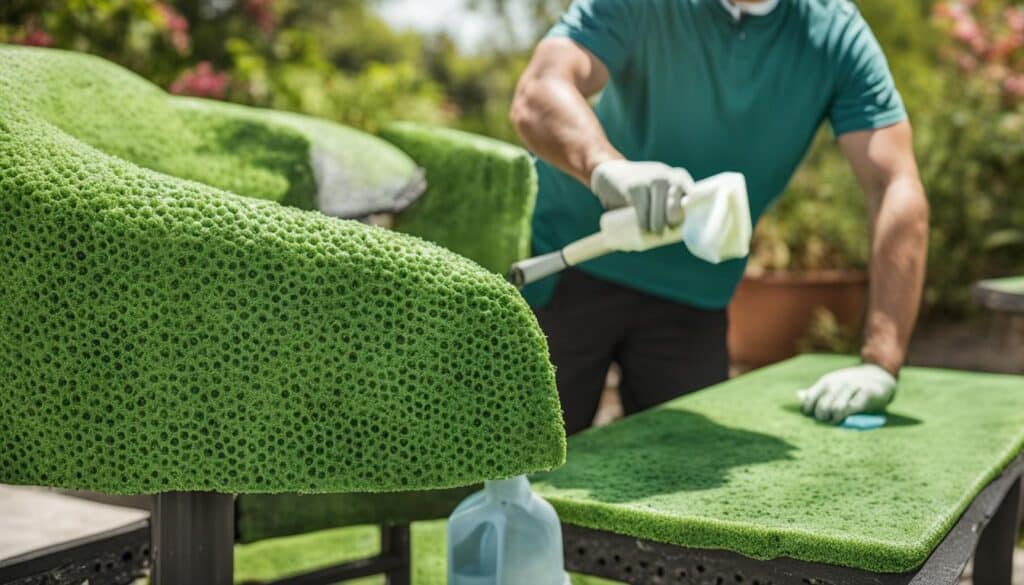
Method 1: Mold Cleaning Product
- Start by selecting a mold cleaning product from your local hardware or home improvement store. Look for products specifically designed for use on plastic surfaces.
- Follow the instructions on the product label for application and safety precautions.
- Apply the cleaning product to the affected areas, making sure to cover the mold completely.
- Allow the cleaning solution to sit on the furniture for the recommended amount of time.
- After the designated time, use a scrub brush or sponge to gently scrub the mold away.
- Rinse the furniture thoroughly with clean water to remove any residue.
Method 2: Vinegar and Water
- If you prefer a natural cleaning solution, you can use vinegar and water to remove mold from plastic patio furniture.
- Mix equal parts white vinegar and water in a spray bottle.
- Spray the mixture onto the moldy areas of the furniture.
- Allow the vinegar solution to sit on the mold for about 15 minutes.
- Scrub the furniture with a brush or sponge to remove the mold.
- Rinse the furniture with clean water to remove any remaining vinegar solution.
Method 3: Bleach and Water
- It’s important to note that using bleach on colored plastic furniture may cause discoloration. Spot test an inconspicuous area first to ensure it doesn’t damage the material.
- If the plastic furniture is white or a light color, you can mix a solution of 1 part bleach to 3 parts water.
- Apply the bleach solution to the moldy areas of the furniture.
- Allow the solution to sit on the mold for about 10 minutes.
- Scrub the furniture with a brush or sponge to remove the mold.
- Rinse the furniture thoroughly with clean water to remove any bleach residue.
Remember to always wear gloves and protective eyewear when cleaning mold, and ensure proper ventilation in the area. Following these DIY methods can help you effectively remove mold from your plastic patio furniture, allowing you to enjoy your outdoor space mold-free.
Cleaning Mold off Wood Outdoor Furniture
Mold can be a common problem on wood outdoor furniture, but with the right cleaning techniques, you can effectively remove it and prevent further growth. Here are some best practices for cleaning mold off your wood outdoor furniture:
- Choose a wood-specific cleaner: Avoid using bleach as it can discolor stained wood. Instead, opt for a cleaner specifically formulated for wood surfaces. Read the label to ensure it is suitable for your type of wood furniture.
- Gently scrub the affected areas: Use a soft-bristle brush or sponge to gently scrub the moldy spots. Avoid using abrasive materials that can damage the wood.
- Rinse thoroughly: After scrubbing, rinse the furniture with clean water to remove any leftover cleaner and mold residue.
- Dry and maintain: Once cleaned, make sure to dry the wood furniture thoroughly to prevent moisture buildup and future mold growth. Regularly inspect and maintain your outdoor furniture to ensure it stays mold-free.
Additional Tips for Wood Outdoor Furniture Maintenance:
- Keep your wood furniture covered when not in use to protect it from excessive moisture and UV rays.
- Avoid placing the furniture in damp, shaded areas as these conditions promote mold growth.
- Apply a protective finish, such as varnish or sealant, to your wood furniture to enhance its resistance to moisture and mold.
- Regularly inspect your furniture for any signs of mold or mildew and address them promptly to prevent further damage.
By following these best practices for cleaning and maintaining your wood outdoor furniture, you can ensure it stays mold-free and in great condition for years to come.
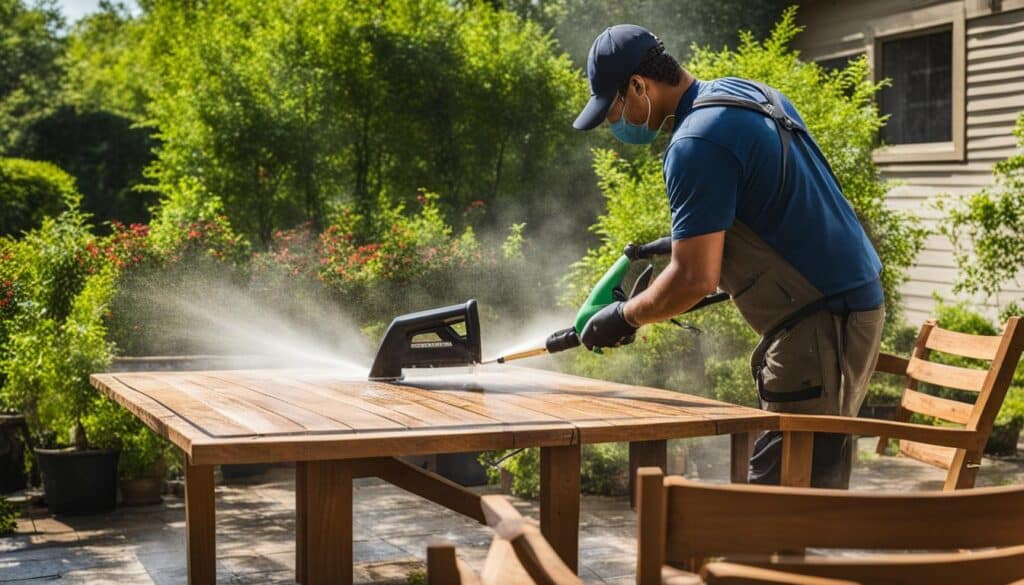
Removing Mold from Outdoor Cushions
Outdoor cushions are a popular addition to any patio or deck, providing comfort and style to your outdoor furniture. However, they are also prone to mold and mildew growth due to their exposure to moisture. If you notice mold stains on your outdoor cushions, it is important to take action promptly to prevent further damage. In this section, we will explore effective methods for removing mold stains from outdoor furniture.
Step 1: Assess the Severity of the Mold
Before starting the cleaning process, it is essential to evaluate the severity of the mold growth on your outdoor cushions. If the stains are minor and surface-level, you can proceed with DIY cleaning methods. However, if the mold growth is extensive or deeply embedded in the fabric, it may be best to seek professional help or consider replacing the cushions altogether.
Step 2: Choose the Right Cleaning Solution
There are several effective cleaning solutions you can use to remove mold stains from outdoor cushions. One option is to create a homemade mold solution using equal parts water and vinegar. Apply this mixture to the affected areas and let it sit for about 15 minutes before scrubbing gently with a brush. Another solution is to mix one part ammonia with three parts water and apply it to the stains, allowing it to sit for a few minutes before rinsing thoroughly. For more stubborn stains, you can try using hydrogen peroxide, lemon salt, or dish soap.
Step 3: Test and Clean the Cushions
Before applying any cleaning solution to the entire cushion, it is crucial to test it on a small, inconspicuous area to ensure it does not cause discoloration or damage. Once you have determined that the solution is safe to use, apply it to the mold stains and gently scrub the area with a brush or sponge. Be sure to work the solution into the fabric and pay extra attention to any crevices or folds where mold may be hiding. After scrubbing, rinse the cushions thoroughly with clean water and allow them to air dry in a well-ventilated area.
By following these steps and using the appropriate cleaning solutions, you can effectively remove mold stains from your outdoor cushions and keep them looking fresh and mold-free.
Preventing Mold on Outdoor Furniture
Mold growth on outdoor furniture can be a frustrating problem to deal with. Fortunately, there are preventive measures you can take to minimize the chances of mold taking hold on your furniture. By following these tips, you can keep your outdoor furniture looking clean and mold-free for years to come.
1. Regular Cleaning and Maintenance
- Regularly clean your outdoor furniture to remove any dirt, debris, and organic matter that can promote mold growth.
- Wash cushions, pillows, and other fabric components according to the manufacturer’s instructions to prevent moisture buildup.
- Ensure that the furniture is completely dry before storing or covering it to prevent mold growth in humid conditions.
2. Proper Airflow and Sunlight Exposure
- Place your outdoor furniture in areas with good airflow to allow moisture to evaporate quickly.
- Avoid placing furniture in shaded areas where sunlight is limited, as sunlight helps to inhibit mold growth.
- If using furniture covers, opt for covers with vents to allow air circulation and prevent moisture buildup.
3. Selecting Mold-Resistant Materials
- Consider choosing outdoor furniture made from mold-resistant materials, such as teak, aluminum, or synthetic wicker.
- Opt for cushions and fabrics that are specifically designed to be mold-resistant, such as those made with Sunbrella fabric.
- When purchasing furniture, look for products that come with a warranty against mold and mildew growth.
By taking these preventive measures, you can significantly reduce the risk of mold growth on your outdoor furniture. Remember to regularly clean and maintain your furniture, ensure proper airflow and sunlight exposure, and choose mold-resistant materials. By doing so, you can enjoy your outdoor living spaces without the worry of mold taking hold.
Conclusion
Congratulations on learning how to effectively clean and prevent mold on your outdoor furniture! By following the right cleaning techniques and taking preventive measures, you can ensure your furniture remains mold-free for years to come.
Remember to regularly clean your outdoor furniture using appropriate tools and cleaners. Whether it’s using bleach, enzyme cleaners, vinegar, or wood-specific cleaners, make sure to read the manufacturer’s instructions and spot test any solutions before applying them.
Additionally, don’t forget about preventive measures. Ensure proper airflow and sunlight exposure for your furniture by keeping it away from shaded areas or using furniture covers with vents. Consider selecting mold-resistant materials, such as Sunbrella fabrics, for your cushions and fabrics to help prevent mold growth.
By maintaining regular cleaning and preventive practices, you can keep your outdoor furniture looking great and mold-free, allowing you to fully enjoy your outdoor living space.
FAQ
How can I effectively remove mold from outdoor furniture?
It is recommended to wear gloves and a mask while cleaning. Use a mixture of water, soap, and bleach for mild cases of mold. Spot test any cleaning products before use, and follow the manufacturer’s instructions. Nylon bristle brushes, garden hoses, towels, spray bottles, soft cloths, washing machines, and enzyme cleaners are useful tools and products for cleaning mold off outdoor furniture.
Can I use bleach to remove mold stains from outdoor furniture?
Yes, bleach can be effective in removing mold stains. However, it’s important to spot test an inconspicuous area first to avoid discoloration, as bleach may affect certain fabrics.
What cleaning methods can I use for plastic patio furniture?
You can use a mold cleaning product, vinegar and water, or a mixture of bleach and water to remove mold from plastic furniture. Spot test any cleaning solutions before use, especially on colored plastic furniture, to prevent discoloration.
How should I clean mold off wood outdoor furniture?
Bleach should be avoided as it can discolor stained wood. Instead, use a wood-specific cleaner to remove mold stains from wood surfaces. Scrub gently and rinse thoroughly. Regular maintenance and drying are essential to prevent future mold growth.
What can I do to remove mold from outdoor cushions?
You can try bleaching, using a homemade mold solution, ammonia, hydrogen peroxide, lemon salt, or dish soap to remove mold from outdoor cushions. Test any cleaning solution on a small area first to avoid discoloration or damage.
How can I prevent mold from growing on outdoor furniture?
Regular cleaning and maintenance, including proper drying and removing standing water, can help prevent mold growth. Ensure proper airflow and sunlight exposure by keeping furniture away from shaded areas or using vented furniture covers. Selecting mold-resistant materials, such as Sunbrella fabrics, can also contribute to mold prevention.


